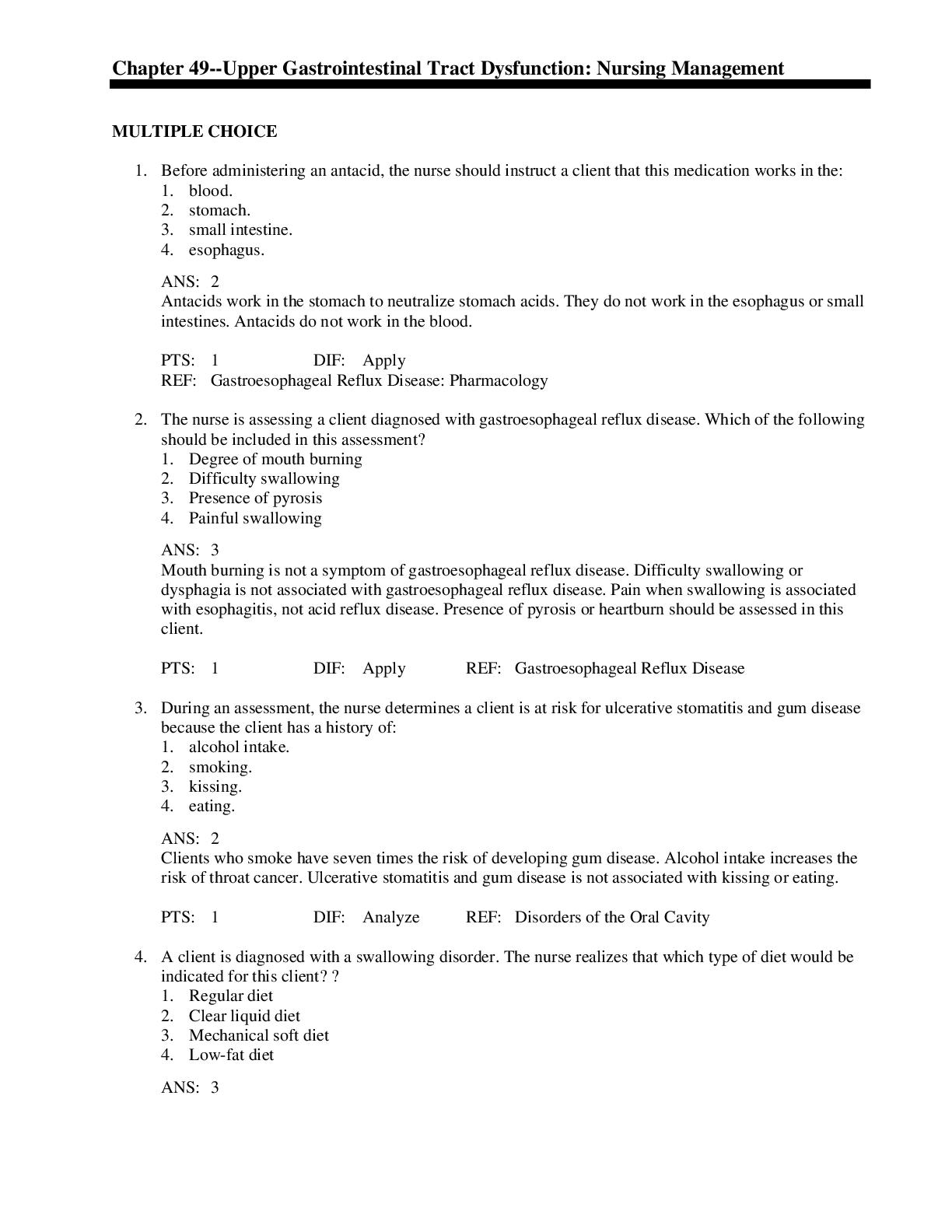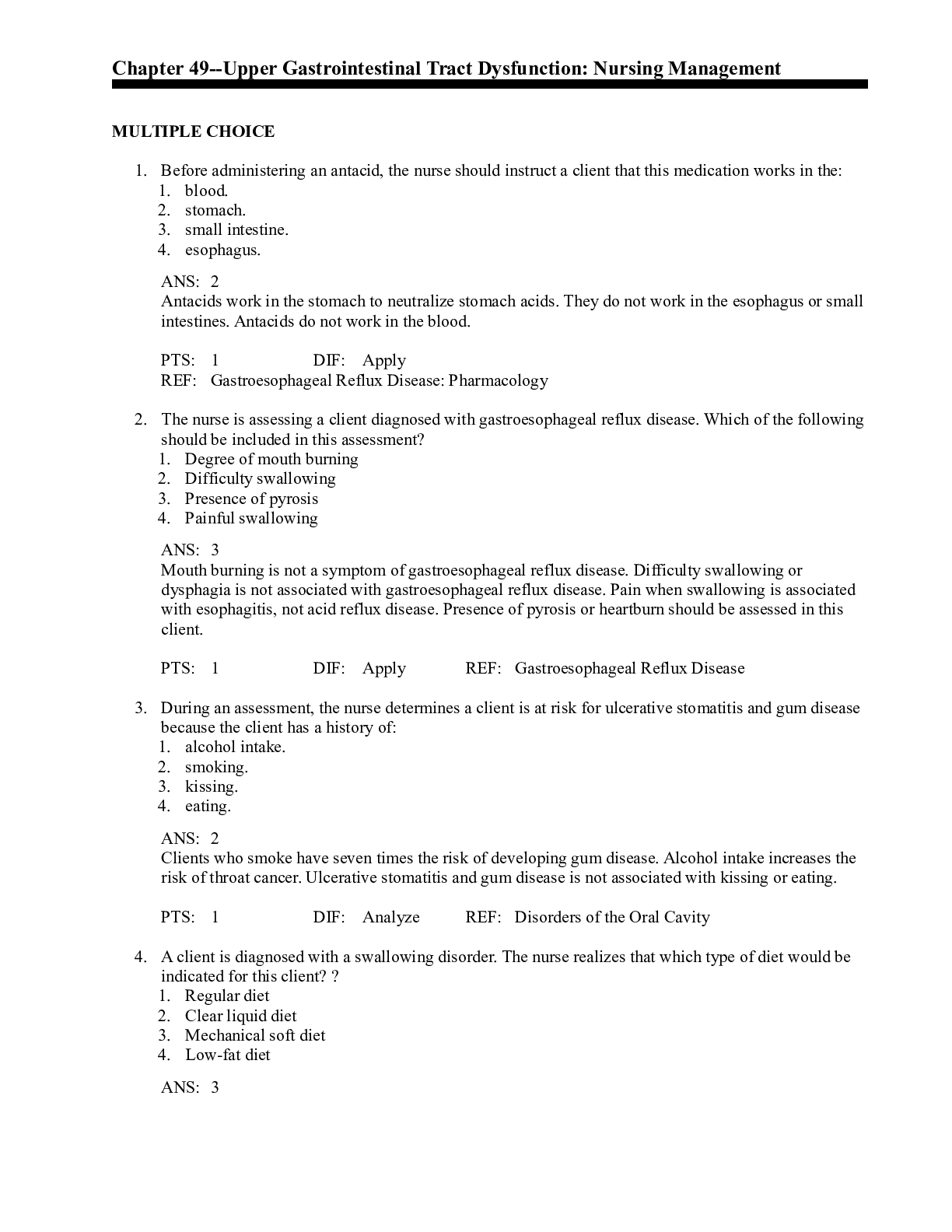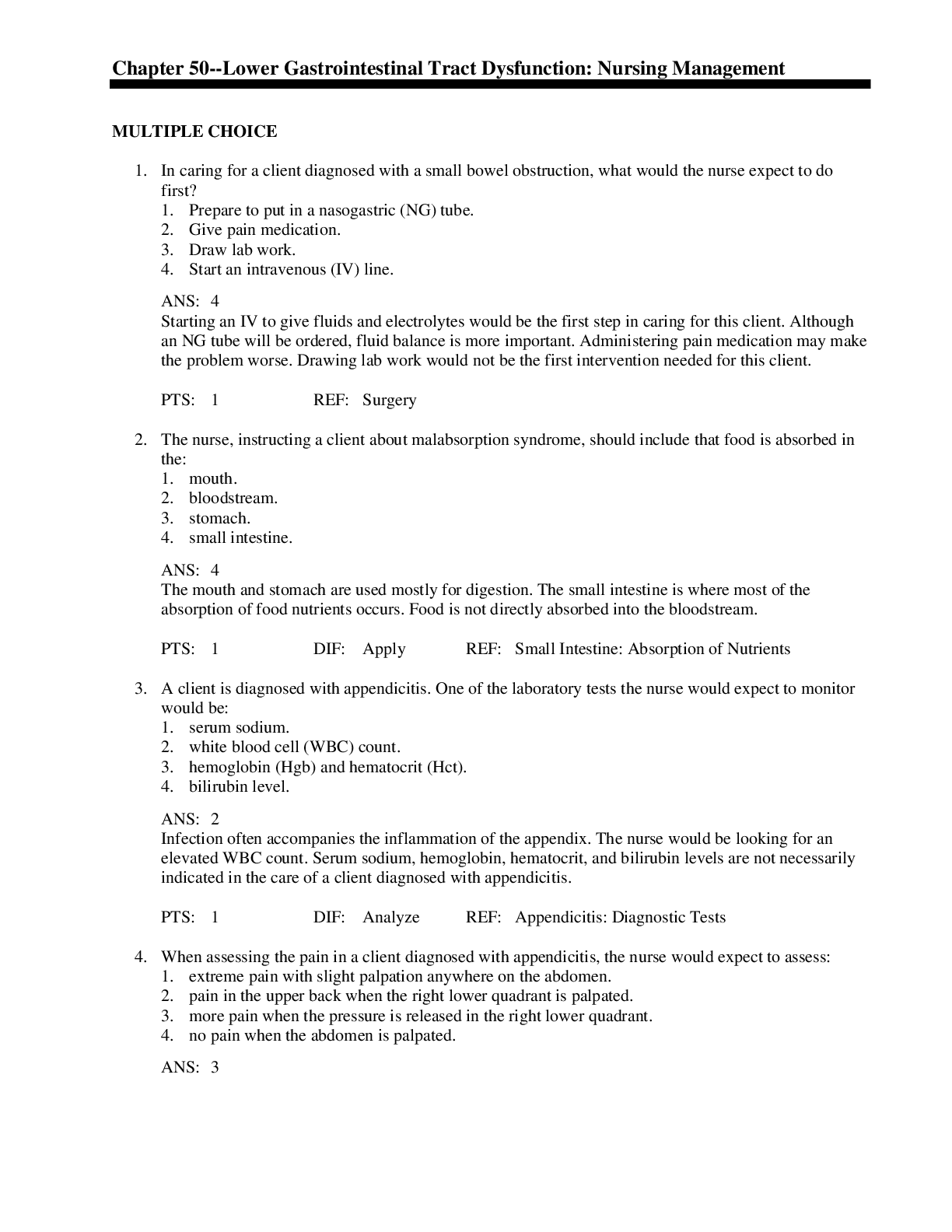*NURSING > QUESTIONS & ANSWERS > Chapter 49--Upper Gastrointestinal Tract Dysfunction: Nursing Management (All)
Chapter 49--Upper Gastrointestinal Tract Dysfunction: Nursing Management
Document Content and Description Below
Chapter 49--Upper Gastrointestinal Tract Dysfunction: Nursing Management MULTIPLE CHOICE 1. Before administering an antacid, the nurse should instruct a client that this medication works in the... : 1. blood. 2. stomach. 3. small intestine. 4. esophagus. PTS: 1 DIF: Apply REF: Gastroesophageal Reflux Disease: Pharmacology 2. The nurse is assessing a client diagnosed with gastroesophageal reflux disease. Which of the following should be included in this assessment? 1. Degree of mouth burning 2. Difficulty swallowing 3. Presence of pyrosis 4. Painful swallowing PTS: 1 DIF: Apply REF: Gastroesophageal Reflux Disease 3. During an assessment, the nurse determines a client is at risk for ulcerative stomatitis and gum disease because the client has a history of: 1. alcohol intake. 2. smoking. 3. kissing. 4. eating. PTS: 1 DIF: Analyze REF: Disorders of the Oral Cavity 4. A client is diagnosed with a swallowing disorder. The nurse realizes that which type of diet would be indicated for this client? ? 1. Regular diet 2. Clear liquid diet 3. Mechanical soft diet 4. Low-fat diet PTS: 1 DIF: Analyze REF: Dysphagia: Nutrition 5. To support the nutritional needs of a client with dysphagia, the nurse realizes that all of the following are mechanisms to provide enteral feeding EXCEPT: 1. nasogastric tube. 2. percutaneous endoscopic gastrostomy (PEG) tube. 3. jejunostomy tube. 4. hyperalimentation. PTS: 1 DIF: Analyze REF: Dysphagia: Nutrition 6. A client is scheduled for diagnostic tests to determine the ability to swallow. Which of the following diagnostic tests will provide the best information regarding this client’s status? 1. Pulse oximetry with water 2. Esophageal transit scintigraphy 3. Videofluoroscopy 4. Esophageal manometry PTS: 1 DIF: Analyze REF: Dysphagia: Diagnostic Tests 7. A client, diagnosed with a hiatal hernia, will experience which of the following symptoms most frequently? 1. Nausea 2. Vomiting 3. Diarrhea 4. Heartburn PTS: 1 DIF: Analyze REF: Hiatal Hernia: Assessment with Clinical Manifestations 8. The nurse is instructing a client diagnosed with a hiatal hernia on ways to reduce the symptoms. Which of the following should be included in these instructions? 1. Eat large meals to keep the stomach full. 2. Drink lots of liquids so that the stomach does not have to work so hard. 3. Avoid lying down after meals. 4. Lie down after eating. PTS: 1 DIF: Apply REF: Hiatal Hernia: Planning and Implementation; Patient Playbook: Patient Education for GERD 9. A client is diagnosed with burning mouth syndrome. Which of the following interventions should be included in this client’s plan of care? 1. Assess the condition of the client’s teeth. 2. Collect a saliva specimen for analysis. 3. Tell the client to avoid vitamin supplements. 4. Teach the client how to conduct an oral self-assessment daily. PTS: 1 DIF: Apply REF: Burning Mouth Syndrome: Planning and Implementation 10. During an assessment, the nurse learns that a client is inhaling while swallowing food. Which of the following does this assessment finding suggest to the nurse? 1. The client is recovering from a stroke. 2. The client is at risk for aspiration. 3. The client will experience dyspepsia. 4. The client has esophageal reflux disease. PTS: 1 DIF: Analyze REF: Dysphagia: Assessment with Clinical Manifestations 11. A client is experiencing brash water. The nurse realizes this symptom is associated with: 1. oral cancer. 2. gastric ulcers. 3. dysphagia. 4. Barrett’s esophagus. PTS: 1 DIF: Analyze REF: Barrett's Esophagus 12. A client has been prescribed Zantac for gastroesophageal reflux disease. The nurse realizes this medication is classified as a: 1. histamine H2-receptor antagonist. 2. proton pump inhibitor. 3. prokinetic agent. 4. antihistamine. PTS: 1 DIF: Analyze REF: Gastroesophageal Reflux Disease: Pharmacology 13. A client is diagnosed with peptic ulcer disease caused by NSAID use. Which of the following would be indicated for this client? 1. Antibiotic therapy 2. Treatment similar to a client with peptic ulcer disease 3. Preparation for surgery 4. Insertion of a nasogastric tube for gastric lavage PTS: 1 DIF: Analyze REF: : Complications of PUD and the Subsequent Therapy MULTIPLE RESPONSE 1. The nurse is instructing a client about symptoms associated with peptic ulcer disease. Which of the following should be included in these instructions? (Select all that apply.) 1. Abdominal pain 2. Pain in the middle of the night 3. Weight loss 4. Poor appetite 5. Bloating 6. Constipation PTS: 1 DIF: Apply REF: Peptic-Ulcer Dyspepsia: Etiology; Assessment with Clinical Manifestations 2. The nurse is planning care for a client diagnosed with oral ulcers. Which of the following should be included in this client’s plan of care? (Select all that apply.) 1. Encourage frequent oral hygiene. 2. Rinse mouth with chlorhexidine. 3. Increase consumption of hot fluids. 4. Instruct in the use of topical corticosteroids. 5. Encourage the client to limit smoking. 6. Avoid the use of dental floss. PTS: 1 DIF: Apply REF: Disorders of the Oral Cavity: Planning and Implementation 3. The nurse is instructing a client on conducting an oral self-assessment. Which of the following should be included in the nurse’s instructions? (Select all that apply.) 1. Check the face for symmetry. 2. Check skin on the face for changes. 3. Check the neck for swellings or lumps. 4. Check inside of cheeks for tenderness. 5. Check the tongue for changes. 6. Check urine for change in color. PTS: 1 DIF: Apply REF: Patient Playbook: Oral Cancer Self-Assessment 4. The nurse is assisting a client with indirect techniques to improve swallowing. Which of the following are techniques included in the nurse’s assistance? (Select all that apply.) 1. Tongue mobility exercises 2. Application of ice 3. Repetitive head lift exercises 4. Positioning 5. Range-of-motion exercises for the neck 6. Range-of-motion exercises for the shoulders PTS: 1 DIF: Apply REF: Box 49-4 Techniques of Swallowing Therapy 5. A client is diagnosed with esophageal pain. Which of the following medications would be indicated for this client? (Select all that apply.) 1. Vasodilators 2. Calcium channel blockers 3. Isosorbide dinitrate 4. Antibiotics 5. Antipyretics 6. Antihistamines PTS: 1 DIF: Analyze REF: Esophageal Pain and Achalasia: Pharmacology [Show More]
Last updated: 1 year ago
Preview 1 out of 6 pages
Instant download

Buy this document to get the full access instantly
Instant Download Access after purchase
Add to cartInstant download
Reviews( 0 )
Document information
Connected school, study & course
About the document
Uploaded On
Jan 28, 2020
Number of pages
6
Written in
Additional information
This document has been written for:
Uploaded
Jan 28, 2020
Downloads
0
Views
45

















